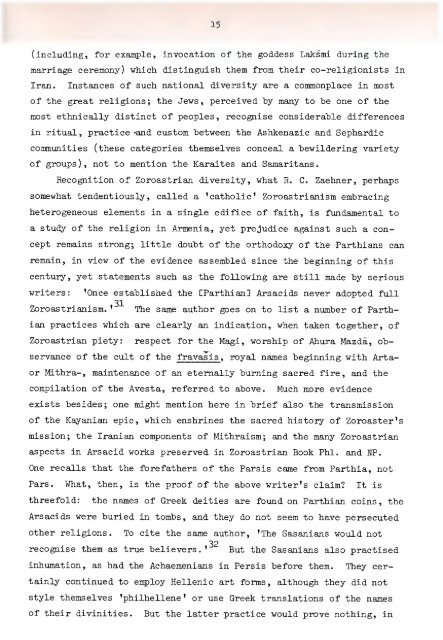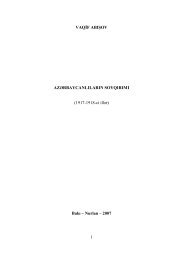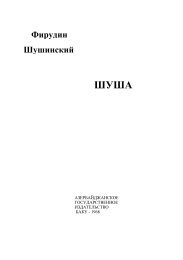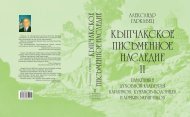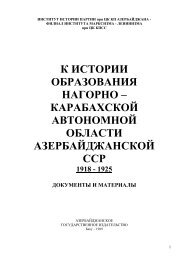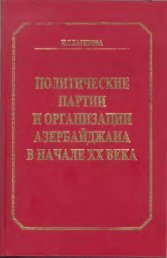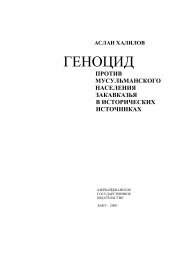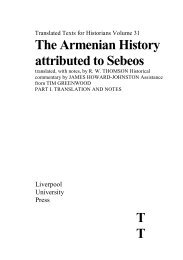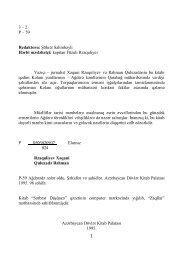- Page 1 and 2: mw m Zoroastrianism . zn Armenia by
- Page 3 and 4: Published by Harvard University Dep
- Page 5 and 6: TABLE 0Ғ CONTENTS Page Acknowledge
- Page 7 and 8: great and venerable prophetic revel
- Page 9 and 10: syncretism. The Armenians generally
- Page 11 and 12: 2 Euphrates, Tigris, Kura, Araxes,
- Page 13 and 14: и Ararat, seeding to float In Heaw
- Page 15 and 16: Armenian spoken language, the image
- Page 17 and 18: 8 scholars have proposed dates rang
- Page 19 and 20: 10 Zoroastrian terms, or telling de
- Page 21 and 22: 12 that the Survani be tiereey v4£
- Page 23: lU influenced Zoroastrian thought i
- Page 27 and 28: 18 Notes - Introduction 1. On physi
- Page 29 and 30: 20 10-a. See, most recently, М. М
- Page 31 and 32: 22 20. The critical edition was edi
- Page 33 and 34: CHAPTER 1 THE ARMENIAN ETHNOGENESIS
- Page 35 and 36: on curly stage. A strik in g sxaspl
- Page 37 and 38: 29 inscriptions at temple sites alw
- Page 39 and 40: 31 The Muski on the Armenian platea
- Page 41 and 42: poplars, and. there is an Urartean
- Page 43 and 44: 35 of Mus (Н. F. B. Lynch, M. Oswa
- Page 45 and 46: 37 42. See E. A. Grantovskii, Ranya
- Page 47 and 48: CHAPTER 2 ARMENIA FROM THE MEDIAN C
- Page 49 and 50: lake.1'" The "buildings of Taxt-i S
- Page 51 and 52: 1*3 the tale recorded by MX in his
- Page 53 and 54: İJ-3 1+1+ •» language. And they
- Page 55 and 56: £0 better). It is possible that th
- Page 57 and 58: 1*9 review some of the evidence we
- Page 59 and 60: 51 99 Dadvah (Phi. Dai), which woul
- Page 61 and 62: these to Valarsak (Pth. Valaxs; Lat
- Page 63 and 64: 55 been interpreted to read as foll
- Page 65 and 66: 51 another king, but the use of the
- Page 67 and 68: 59 Notes - Chapter 2 С с ^ с _ 1
- Page 69 and 70: I 6 ı 1976, 68, 71*, 77, 101) . Hr
- Page 71 and 72: бз various compounds (azdahä-fas
- Page 73 and 74: 65 59- Strabo, XI.lU.15; on Hydarne
- Page 75 and 76:
67 ending its present state of mixt
- Page 77 and 78:
69 109- See S. T. Eremyan, 'Osnovny
- Page 79 and 80:
71 138. See С. Habicht, 'Über ein
- Page 81 and 82:
toponymical suffix; the name of the
- Page 83 and 84:
MIr. пет 'brave ', a common roya
- Page 85 and 86:
78 important information about the
- Page 87 and 88:
80 From the foregoing it would seem
- Page 89 and 90:
82 of his cult in Armenia is eloque
- Page 91 and 92:
8U Armenian scholars have suggested
- Page 93 and 94:
86 provinces which had been ruled s
- Page 95 and 96:
88 каге апзрСоѣСаЬа
- Page 97 and 98:
90 invaders, and for Eznik the azgn
- Page 99 and 100:
92 trepidation the news of the over
- Page 101 and 102:
9b Phraates IV (ca. 38-2 B.C.). The
- Page 103 and 104:
96 he had a daughter, Arpcenik; Ъ
- Page 105 and 106:
98 also a possible derivation of th
- Page 107 and 108:
100 himself; one notes the decorati
- Page 109 and 110:
102 indeed, we have bas-reliefs of
- Page 111 and 112:
ıoU continually addressed as 'swif
- Page 113 and 114:
ю б 78. Hubschmann, Arm Gr* 120,
- Page 115 and 116:
ıo8 100. Arm. G r ., 25-6. 101. Se
- Page 117 and 118:
110 nrysfyzd *Narısaf yazd. In Man
- Page 119 and 120:
CHAPTER Ц ARMENIA UNDER THE PARTHI
- Page 121 and 122:
115 whose cherished image-shrines a
- Page 123 and 124:
117 interwoven with that of Abgar I
- Page 125 and 126:
119 О) j WLGS (U) MLK;"' it is tra
- Page 127 and 128:
121 absence o f m a t e ria l e v i
- Page 129 and 130:
123 suggested th a t 'A nak' was on
- Page 131 and 132:
125 Caesarea in 3lU, i.e., in the s
- Page 133 and 134:
127 Astisat. St. Gregory took immed
- Page 135 and 136:
129 с с с с Hayoc0, gawarac gaw
- Page 137 and 138:
131 legal precedent: Arsak's faithf
- Page 139 and 140:
133 to Armenia. The biography of th
- Page 141 and 142:
135 commercial and administrative p
- Page 143 and 144:
137 Whilst the two leaders of the p
- Page 145 and 146:
139 needful request of the three is
- Page 147 and 148:
ll+l Notes - Chapter U 1. S. T. Ere
- Page 149 and 150:
1^3 13. J. В. Segal, Edessa, the B
- Page 151 and 152:
1U5 Tansar', a mediaeval document b
- Page 153 and 154:
Iff outside the aegis of the rule o
- Page 155 and 156:
İ»ı9 76. L. A. El'nitskii, 'K is
- Page 157 and 158:
151 К. Czegledy, 'Bahram Cobın an
- Page 159 and 160:
CHAPTER 5 ARAMAZD Having observed t
- Page 161 and 162:
155 Fire, the most important symbol
- Page 163 and 164:
V found in early texts, but they ar
- Page 165 and 166:
159 laws of purity. Fatness (Av. az
- Page 167 and 168:
made to Aramazday awtarasirin '(of)
- Page 169 and 170:
g of pseudo-Callisthenes, Alexander
- Page 171 and 172:
165 Armenia, there are mountains wh
- Page 173 and 174:
£2 mentions an epistle of Mani to
- Page 175 and 176:
169 periods of 3000 years' duration
- Page 177 and 178:
171 Наук, refused to submit to
- Page 179 and 180:
173 yet It seems sound to suggest t
- Page 181 and 182:
175 western border of Armenia, in C
- Page 183 and 184:
ITT 12. Gray, op. cit., 24; Boyce,
- Page 185 and 186:
179 29- Here used as pluralis tanta
- Page 187 and 188:
ı8ı 60. Ibid., 34; on Sabalan in
- Page 189 and 190:
183 89. H. S. Anasyan, Haykakan mat
- Page 191 and 192:
185 Юб. Corpus Inscr. Sent., II,
- Page 193 and 194:
187 Chapter Five. Platfc 1. View fr
- Page 195 and 196:
100 discussion here. Mount Sabalan,
- Page 197 and 198:
г 192 heraldic animal of the Arm.
- Page 199 and 200:
ışU: 1 Nawasard, the ancient New
- Page 201 and 202:
1 # (Zurvan) so that Ohrmazd might
- Page 203 and 204:
The bamb"rn was probably a stringed
- Page 205 and 206:
2Q0 52 hıgh-priest Arjan goes out
- Page 207 and 208:
2,02 sons are probably fictional, e
- Page 209 and 210:
2СЖ of h e l l 1 or Diwtim 'House
- Page 211 and 212:
ew bnaJmtCiwns 'They say some have
- Page 213 and 214:
applications of the word than does
- Page 215 and 216:
Zlfy god. Teiseba was one of the me
- Page 217 and 218:
of Zod, ca. 12 km. east of Basargec
- Page 219 and 220:
sffi. с с с According to the sev
- Page 221 and 222:
гг € important The Arm. Synaxar
- Page 223 and 224:
гхе Notes - Chapter 6 1. See Ch.
- Page 225 and 226:
23. Sir (Mark) Aurel Stein, Old Rou
- Page 227 and 228:
222 50. ZG, lU. 51. Ibid., 25. 52.
- Page 229 and 230:
22k 75- Sahnazarean, Lusaberd, 26.
- Page 231 and 232:
ЮТ. 107-а. 108. 109. 110. 111. 1
- Page 233 and 234:
228 133. Ananikian, pi. II; АНН,
- Page 235 and 236:
PLATE I . r 230
- Page 237 and 238:
232
- Page 239 and 240:
PLATE V. *it 234
- Page 241 and 242:
23 б The mother goddess is referre
- Page 243 and 244:
238 gods of pagan Mesopotamia rathe
- Page 245 and 246:
2k0 either side. The inscription on
- Page 247 and 248:
2k2 on both sides to the base of th
- Page 249 and 250:
zhh sacrifice to an alien goddess,
- Page 251 and 252:
2k6 There was a great and ornate te
- Page 253 and 254:
246 from brave Vahagn' (Agath. 127)
- Page 255 and 256:
250 and the town appears to have be
- Page 257 and 258:
252 as we have seen, is preeminentl
- Page 259 and 260:
A Notes - Chapter 7 1. M. J. Vermas
- Page 261 and 262:
256 a topographical feature. G. Hal
- Page 263 and 264:
258 53. A Christensen, L'lran sous
- Page 265 and 266:
2б0 NanaxatCun 'Nana the Lady', fr
- Page 267 and 268:
262 a triad of yazatas: Ahura Mazda
- Page 269 and 270:
264 Оизпейр {Arm. Vanaspl. I
- Page 271 and 272:
266 Sasanian period emphasise the P
- Page 273 and 274:
268 The Parthian Arsacids who came
- Page 275 and 276:
270 priest^0 to the great cave C)^1
- Page 277 and 278:
Pseudo-Plutarchus as to t5n gynaikd
- Page 279 and 280:
2jb into stone (cf. confinement in
- Page 281 and 282:
276 18. On the M ehnunis, see ZG, b
- Page 283 and 284:
278 Valarsapat, l880, 51, cit. Ъу
- Page 285 and 286:
280 ЭСПІ.18). John Chrysostom l
- Page 287 and 288:
282 65. M i ’ 96. 66. See Sahinya
- Page 289 and 290:
PI. Is The building at Garni. 284
- Page 291 and 292:
PI. 3: Mheri durn. Van (Avandapatum
- Page 293 and 294:
CHAPTER 9 TIE Nabü In the Babyloni
- Page 295 and 296:
291 Dionysos as Spandaramet in Macc
- Page 297 and 298:
jib St. Gregory the Illuminator, 29
- Page 299 and 300:
295 and Hubschmann mention a villag
- Page 301 and 302:
297 apparently located near the cou
- Page 303 and 304:
299 southwest of Greater Armenia. I
- Page 305 and 306:
301 itself is rare in early texts;
- Page 307 and 308:
303 quite merciless,/for you make m
- Page 309 and 310:
305 first Iranians to adopt his cul
- Page 311 and 312:
307 for works on astrology. What of
- Page 313 and 314:
309 attribution of magical powers o
- Page 315 and 316:
311 Ліе le^tend of the
- Page 317 and 318:
313 İĞ, M. Boyce, Zoroastrians, o
- Page 319 and 320:
315 48. Hubschmann, op. cit. n. 4o,
- Page 321 and 322:
317 83. В, Aiayan, Ardi hayerenl b
- Page 323 and 324:
319 lines 251-3; T. Goell, 'The Exc
- Page 325 and 326:
321 138. MA I, З8З-З88. 139. V.
- Page 327 and 328:
7 Armaiti'.‘ Yet it seems that mo
- Page 329 and 330:
32 б one', perhaps ал epithet of
- Page 331 and 332:
328 kakcaw-dance had some religious
- Page 333 and 334:
330 in ^ V ^ vineyards. Hubschmann
- Page 335 and 336:
astray from his Creator.' 332 * с
- Page 337 and 338:
ЗЗ1» svod continued to be consid
- Page 339 and 340:
I 336 i Hayastan asxarhis, ew кс
- Page 341 and 342:
338 Hellenistic period northeast of
- Page 343 and 344:
3İ*0 had Ъееп worshipped on lo
- Page 345 and 346:
3**2 engaged in sodorny,] and his m
- Page 347 and 348:
зм. Zoroastrian times into the Ch
- Page 349 and 350:
ЗШ mind. A fte r a l l , Herodotu
- Page 351 and 352:
3U8 serve th e in te r e s ts o f h
- Page 353 and 354:
350 20. ТСА 1 .8 . 21. MA 3, t5
- Page 355 and 356:
352 «г С С V 55- Arm. sahapetk
- Page 357 and 358:
35b a s i l v e r - g i l t p la te
- Page 359 and 360:
356 1 0 2 . Cf. PCB IV , 2k and Ch.
- Page 361 and 362:
358 135- MA 7, 27, citing АН, II,
- Page 363 and 364:
CHAPTER 11 TORKC AHGEfcEAY Nergal T
- Page 365 and 366:
збз Vahagn. By th e la te n in t
- Page 367 and 368:
25 &ЪоѴе th a t o f a l l th e
- Page 369 and 370:
Збт Гисе (ѴдІЫЭак) c
- Page 371 and 372:
O rontid tim es. 3 69 I t is unsafe
- Page 373 and 374:
Notes - C hapter 11 E. Dhorme, Les
- Page 375 and 376:
373 32. See H. A carean, H ayeren a
- Page 377 and 378:
37 б on w hich g i r l s go o u t
- Page 379 and 380:
378 and b an ish s le e p , and to
- Page 381 and 382:
380 S p e n ta s), and mixed w ith
- Page 383 and 384:
382 I t appears th a t Ъу th a t
- Page 385 and 386:
38U K ari nap at urn, yusam atean B
- Page 387 and 388:
386 As is seen from th e above p as
- Page 389 and 390:
388 fire -te m p le s . There is a
- Page 391 and 392:
390 perhaps fo r th a t reason th a
- Page 393 and 394:
392 f e s t i v a l on Nawasard was
- Page 395 and 396:
391* 35. HAB, I I I , 139-^0. 36. S
- Page 397 and 398:
396 58. The A rjern b a ra ra n , 7
- Page 399 and 400:
390 92. The word a rta x u r may Ъ
- Page 401 and 402:
Uoo in te rv e n in g ages to an e
- Page 403 and 404:
1т ro y a l a n c e s to rs . ' 40
- Page 405 and 406:
hok and w h ite dogs may Ъе com p
- Page 407 and 408:
1*06 c h il d PCoxuac e s , i n c c
- Page 409 and 410:
1+7 A r ta x ia d T igran I I . A r
- Page 411 and 412:
Uıo h is c a r r ia g e by an ays_
- Page 413 and 414:
Һ12 by W illia m B u tle r Y e a t
- Page 415 and 416:
UıU harkanen znora zawrs ew sp a r
- Page 417 and 418:
Ш6 I t i s u n lik e ly t h a t Ar
- Page 419 and 420:
1+18 wounded.: e v e r p ie r c e d
- Page 421 and 422:
----------------------------------
- Page 423 and 424:
1+22 In A rtam et th e r e i s a p
- Page 425 and 426:
y o u th s e t o f f and a r r iv e
- Page 427 and 428:
1+26 N otes - C hapter 13 1 . See C
- Page 429 and 430:
Һ28 c e n t . ) , Vasn krapaş-çu
- Page 431 and 432:
изо 68. Arm. k in c , i s a v a
- Page 433 and 434:
1*32 9 0 . Arm. ayr k c a j ■ К
- Page 435 and 436:
һзһ f o l . 12 Ъ (Н. Hakobyan,
- Page 437 and 438:
CHAPTER lit EVIL SPIRITS AND CREATU
- Page 439 and 440:
k39 beneath the e a r t h ' to whom
- Page 441 and 442:
I+İJİ p o s s ib ly o f th e same
- Page 443 and 444:
һһз etym ology (n o te v . t . d
- Page 445 and 446:
lıU5 d e a ir e d tlıe Sun, i t i
- Page 447 and 448:
Numerous other e v i l s p i r i t
- Page 449 and 450:
і*і*9 The t Ct)3-a (o r t cep-4 ,
- Page 451 and 452:
'•51 о г с е з i x tr a n a
- Page 453 and 454:
U53 In th e Armenian e p ic o f S a
- Page 455 and 456:
Ь55 A nother demon w hose name i s
- Page 457 and 458:
l8 '7 tem p tin g men in t h e i r
- Page 459 and 460:
1*5 9 The snake and s c o r p io n
- Page 461 and 462:
U6i th r e e n a i l s in h is h a
- Page 463 and 464:
һбз Who c a re s n ought f o r t
- Page 465 and 466:
U65 Notes - C hapter lU 1. DruJ is
- Page 467 and 468:
J«ĞT 29. This etymology was propo
- Page 469 and 470:
Һ69 $b. Arm. k cu e (a y ). See HA
- Page 471 and 472:
Ut i 8U. On th e И г . etymology
- Page 473 and 474:
1*73 103. These are p u r if ie d w
- Page 475 and 476:
U75 Наук” 'High A rm enia', a
- Page 477 and 478:
477 161. L. S. H e ra ld , I b i s
- Page 479 and 480:
479 201- Matean olbergut еад ('B
- Page 481 and 482:
CHAPTER 15 THE FIRE CULT In th e Z
- Page 483 and 484:
1)83 *basnbed, Sgd. g-ynpt *faghnpa
- Page 485 and 486:
!ı85 - 0)ı stream s o f l i v i n
- Page 487 and 488:
C h ris tia n ity and subm itted to
- Page 489 and 490:
1)89 p i l l a r , and f i r e v e
- Page 491 and 492:
U91 o f g o b let and a l t a r - f
- Page 493 and 494:
!і93 t h e i r b ro th e rs ; may
- Page 495 and 496:
h ere. Two l a t e r n o tic e s o
- Page 497 and 498:
p ad rö sag ; th e gen eral word f
- Page 499 and 500:
Һ99 o f th e sh rin e o f M ihr, w
- Page 501 and 502:
501 The Arm. c e le b ra tio n prov
- Page 503 and 504:
seems th a t as th e f e a s t spre
- Page 505 and 506:
505 and Ramin, Vis is b u rie d n e
- Page 507 and 508:
507 xung, K urdish xung 'in c e n s
- Page 509 and 510:
509 1+6. The p a in tin g , from Er
- Page 511 and 512:
■ 511 IV -XI d areri sinararakan
- Page 513 and 514:
513 87- A b l t c cean, 'Hay hin ir
- Page 515 and 516:
CHAPTER 1 6 CHILDREN OF THE SUN We
- Page 517 and 518:
517 c entu ry , although i t may Ъ
- Page 519 and 520:
519 wu zu r g-fram adar 'Prim e M i
- Page 521 and 522:
521 . с su g g ested th a t th e s
- Page 523 and 524:
523 morning and west in the afterno
- Page 525 and 526:
525 in their citations of invocatio
- Page 527 and 528:
The fine poetical and polemical dis
- Page 529 and 530:
529 Notes - Chapter 16 1. St. Basil
- Page 531 and 532:
531 19- Conybeare, Cat. Arm MSS Bri
- Page 533 and 534:
533 1*2. Joseph von Hammer, trans.
- Page 535 and 536:
535 command, of Christ desire and s
- Page 537 and 538:
537 gives it to a Christian, that o
- Page 539 and 540:
'1 539 С С ч*0 . с с mnac eals
- Page 541 and 542:
5һ2 A r m . G r . - H. Hubschmann,
- Page 543 and 544:
5kk JAOS - Journal of the American
- Page 545 and 546:
5b6 Ү. or Y s . - Yasna. YM - Yovh
- Page 547 and 548:
ortnography only where clarity woul
- Page 549 and 550:
550 P. Z. Bedoukian, Coinage of the
- Page 551 and 552:
552 J. Labourt, La Christianisme da
- Page 553 and 554:
55һ К. V. Trever, Ocherki во Is
- Page 555 and 556:
556 historical Armenia based upon C
- Page 557 and 558:
INDEX Abdisoy, St., 1 7!+ Abeiyan,
- Page 559 and 560:
561 Argos, 1б1 Ariamnes, 93 Ariara
- Page 561 and 562:
563 Bernard, P., 192 Berossus, 25 B
- Page 563 and 564:
565 Dura Europos, 30б,3бі fresco
- Page 565 and 566:
567 Hambaru, 1*1*9 Hamkars, 323 Ham
- Page 567 and 568:
569 Koriwn, 133,13^,156,15T,U56 Kos
- Page 569 and 570:
571 Mutc asxarh, 'world of dark', 3
- Page 571 and 572:
573 Rasnu (continued) Rasn, 422 Ras
- Page 573 and 574:
575 Syrians, 13,77 weather gpd amon
- Page 575 and 576:
577 Mills, C.J., 46l Winged circle,


